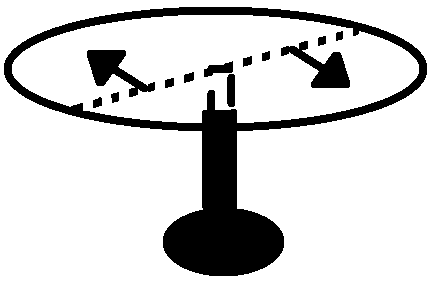
A horizontal circular platform of radius 0.5 m and mass 0.45 kg is free to rotate about its axis. Two massless spring toy guns, each carrying a steel ball of mass 0.05 kg are attached to the platform at a distance 0.25 m from the centre on either side along its diameter (see figure). Each gun simultaneously fires the ball horizontally and perpendicular to the diameter in opposite directions. After leaving the platform, the ball has a horizontal speed of \[9m{s^{ - 1}}\] with respect to the ground. The rotational speed of the platform in \[rad{s^{ - 1}}\] after the balls leave the platform is?

Answer
216.3k+ views
Hint: A vector quantity that is a way of measuring the radial momentum of a rotating object or system and is focused along the axis of rotation is known as angular momentum. It is equal to the product of the system or object's moment of inertia and its angular velocity relating to the axis of rotation.
Formula Used:
Conservation of angular momentum i.e,
\[I\omega = constant\]
where I is the moment of inertia and \[\omega \] is the angular velocity.
Complete step by step solution:
As we have to find the rotational speed of the platform after the balls leave the platform, we can apply the conservation of angular momentum to find it. Let the two angular momentums be \[{L_1} = {I_1}{\omega _1}\] and \[{L_2} = {\left( {mvr} \right)_2}\].
Using the conservation of angular momentum, we get,
\[{I_1}{\omega _1} = {\left( {mvr} \right)_2} \\
\Rightarrow \left( {0.45 \times 0.5 \times 0.25} \right){\omega _1} = 2 \times 0.05 \times 9 \times 0.25 \\
\Rightarrow {\omega _1} = \dfrac{9}{{0.45 \times 5}} \\
\Rightarrow {\omega _1} = 4\,rad{s^{ - 1}} \]
So, the rotational speed of the platform after the balls leave the platform is \[4\,rad{s^{ - 1}}\].
Note: While applying the values in the formula, see to it which value of mass and distance is applied to which of the object, platform, or steel ball, to conserve. As inertia is a product of the mass and the distance, the product of inertia and angular velocity can be expressed as the product of mass and linear velocity. As mass and linear velocity are constant, the product of inertia and angular velocity is also constant.
Formula Used:
Conservation of angular momentum i.e,
\[I\omega = constant\]
where I is the moment of inertia and \[\omega \] is the angular velocity.
Complete step by step solution:
As we have to find the rotational speed of the platform after the balls leave the platform, we can apply the conservation of angular momentum to find it. Let the two angular momentums be \[{L_1} = {I_1}{\omega _1}\] and \[{L_2} = {\left( {mvr} \right)_2}\].
Using the conservation of angular momentum, we get,
\[{I_1}{\omega _1} = {\left( {mvr} \right)_2} \\
\Rightarrow \left( {0.45 \times 0.5 \times 0.25} \right){\omega _1} = 2 \times 0.05 \times 9 \times 0.25 \\
\Rightarrow {\omega _1} = \dfrac{9}{{0.45 \times 5}} \\
\Rightarrow {\omega _1} = 4\,rad{s^{ - 1}} \]
So, the rotational speed of the platform after the balls leave the platform is \[4\,rad{s^{ - 1}}\].
Note: While applying the values in the formula, see to it which value of mass and distance is applied to which of the object, platform, or steel ball, to conserve. As inertia is a product of the mass and the distance, the product of inertia and angular velocity can be expressed as the product of mass and linear velocity. As mass and linear velocity are constant, the product of inertia and angular velocity is also constant.
Recently Updated Pages
JEE Atomic Structure and Chemical Bonding important Concepts and Tips

JEE Amino Acids and Peptides Important Concepts and Tips for Exam Preparation

Electricity and Magnetism Explained: Key Concepts & Applications

Chemical Properties of Hydrogen - Important Concepts for JEE Exam Preparation

JEE Energetics Important Concepts and Tips for Exam Preparation

JEE Isolation, Preparation and Properties of Non-metals Important Concepts and Tips for Exam Preparation

Trending doubts
JEE Main 2026: Application Form Open, Exam Dates, Syllabus, Eligibility & Question Papers

Derivation of Equation of Trajectory Explained for Students

Hybridisation in Chemistry – Concept, Types & Applications

Understanding the Angle of Deviation in a Prism

Understanding Collisions: Types and Examples for Students

How to Convert a Galvanometer into an Ammeter or Voltmeter

Other Pages
JEE Advanced Marks vs Ranks 2025: Understanding Category-wise Qualifying Marks and Previous Year Cut-offs

Units And Measurements Class 11 Physics Chapter 1 CBSE Notes - 2025-26

NCERT Solutions For Class 11 Physics Chapter 8 Mechanical Properties Of Solids

Motion in a Straight Line Class 11 Physics Chapter 2 CBSE Notes - 2025-26

NCERT Solutions for Class 11 Physics Chapter 7 Gravitation 2025-26

Understanding Atomic Structure for Beginners




